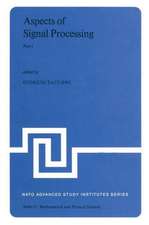Hidden Biometrics: When Biometric Security Meets Biomedical Engineering: Series in BioEngineering
Editat de Amine Nait-alien Limba Engleză Hardback – 23 oct 2019
The book is suitable for advanced graduate and postgraduate students, engineers and researchers, especially in Signal and Image Processing, Biometrics, and Biomedical Engineering.
Din seria Series in BioEngineering
- 15%
 Preț: 576.89 lei
Preț: 576.89 lei - 5%
 Preț: 995.70 lei
Preț: 995.70 lei - 5%
 Preț: 1164.31 lei
Preț: 1164.31 lei - 5%
 Preț: 720.84 lei
Preț: 720.84 lei - 5%
 Preț: 716.45 lei
Preț: 716.45 lei - 15%
 Preț: 643.65 lei
Preț: 643.65 lei - 5%
 Preț: 729.98 lei
Preț: 729.98 lei - 5%
 Preț: 711.88 lei
Preț: 711.88 lei - 5%
 Preț: 1104.48 lei
Preț: 1104.48 lei - 5%
 Preț: 1432.38 lei
Preț: 1432.38 lei - 5%
 Preț: 1413.56 lei
Preț: 1413.56 lei - 5%
 Preț: 1100.09 lei
Preț: 1100.09 lei - 5%
 Preț: 1289.76 lei
Preț: 1289.76 lei - 5%
 Preț: 727.08 lei
Preț: 727.08 lei - 5%
 Preț: 1299.81 lei
Preț: 1299.81 lei - 5%
 Preț: 719.02 lei
Preț: 719.02 lei - 5%
 Preț: 1166.49 lei
Preț: 1166.49 lei - 5%
 Preț: 724.29 lei
Preț: 724.29 lei - 15%
 Preț: 639.90 lei
Preț: 639.90 lei - 5%
 Preț: 1288.99 lei
Preț: 1288.99 lei - 5%
 Preț: 1048.90 lei
Preț: 1048.90 lei - 5%
 Preț: 1164.10 lei
Preț: 1164.10 lei - 5%
 Preț: 1165.40 lei
Preț: 1165.40 lei - 5%
 Preț: 714.46 lei
Preț: 714.46 lei - 5%
 Preț: 1150.98 lei
Preț: 1150.98 lei - 5%
 Preț: 643.87 lei
Preț: 643.87 lei - 5%
 Preț: 1291.57 lei
Preț: 1291.57 lei - 15%
 Preț: 638.57 lei
Preț: 638.57 lei
Preț: 726.37 lei
Preț vechi: 885.82 lei
-18% Nou
Puncte Express: 1090
Preț estimativ în valută:
139.01€ • 144.59$ • 114.76£
139.01€ • 144.59$ • 114.76£
Carte tipărită la comandă
Livrare economică 14-28 aprilie
Preluare comenzi: 021 569.72.76
Specificații
ISBN-13: 9789811309557
ISBN-10: 9811309558
Pagini: 240
Ilustrații: X, 202 p. 109 illus., 44 illus. in color.
Dimensiuni: 155 x 235 x 13 mm
Greutate: 0.41 kg
Ediția:1st ed. 2020
Editura: Springer Nature Singapore
Colecția Springer
Seria Series in BioEngineering
Locul publicării:Singapore, Singapore
ISBN-10: 9811309558
Pagini: 240
Ilustrații: X, 202 p. 109 illus., 44 illus. in color.
Dimensiuni: 155 x 235 x 13 mm
Greutate: 0.41 kg
Ediția:1st ed. 2020
Editura: Springer Nature Singapore
Colecția Springer
Seria Series in BioEngineering
Locul publicării:Singapore, Singapore
Cuprins
Biometric security: a review.- Individual verification using ECG.- EEG signal analysis for biometric applications.- EMG signal as bio‐signature.- Human identification using X‐ray images.- Brain biometrics.- Eye movement analysis in Biometrics.- Vein image analysis.- Retinal image processing in Biometrics.- Multispectral biometric modalities.- Dental biometrics.
Notă biografică
Professor Amine NAIT-ALI was born in 1972. In 1994 he received his M.Sc. degree in Electrical Engineering “Ingénieur d’état en électronique” from the university USTO (Oran), then his DEA degree “Diplôme des Etudes Approfondies” in Signal Processing and Automatic from the University Paris XI (1995). In 1998, he received his Ph.D. degree in Biosignal Processing and the “Habilitation à Diriger des Recherches” (HDR) from the University Paris XII, in 2007. He was an Associate Professor and is currently a Full Professor at the same university. His research interests are focused on biosignal processing, biometrics, optimization, modeling and medical signal and image compression. He has co-authored a number of international peer-reviewed papers and edited and co-edited five books in the biomedical and biometrics field (Springer, ISTE-Wiley and Hermes). He has organized and/or run several national, European and international workshops, and serves as General Chair of theInternational Conference of Bio-engineering for Smart Technologies (BioSMART). He also served as a reviewer for IEEE Transaction on Biomedical Engineering, EURASIP Journal on Advances in Signal Processing, Biomedical Signal Processing and Control and Digital Signal Processing. Prof. Amine NAIT-ALI is a member of IEEE, SFGBM, GDR ISIS and STIC-Santé and, he is the IEEE Biomedical Engineering Society representative in the IEEE Biometrics Council.
Textul de pe ultima copertă
This book explores intrinsic and human body part biometrics and biometrics of human physiological activities, invisible to the naked eye. This includes, for instance, brain structures, skeleton morphology, heart activity, etc. These human body parts can only be visualized using specific imaging techniques or sensors, commonly employed in the biomedical engineering field. As such, the book connects two fields, namely biometric security and biomedical engineering.
The book is suitable for advanced graduate and postgraduate students, engineers and researchers, especially in Signal and Image Processing, Biometrics, and Biomedical Engineering.
The book is suitable for advanced graduate and postgraduate students, engineers and researchers, especially in Signal and Image Processing, Biometrics, and Biomedical Engineering.
Caracteristici
Explores intrinsic and human body part biometrics and biometrics of human physiological activities, invisible to the naked eye Features biometrics of brain structures, heart activity, and skeleton morphology Connects two fields: biometric security and biomedical engineering




















